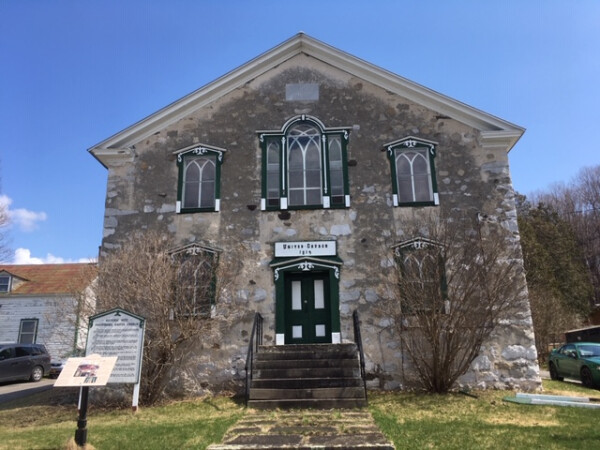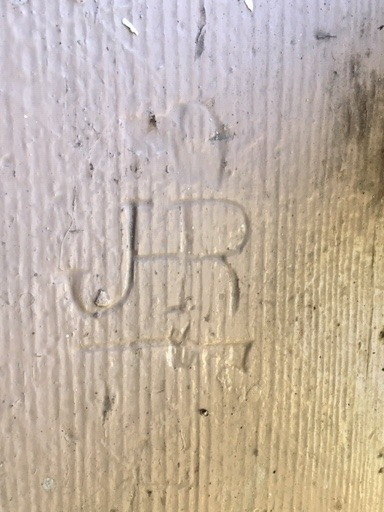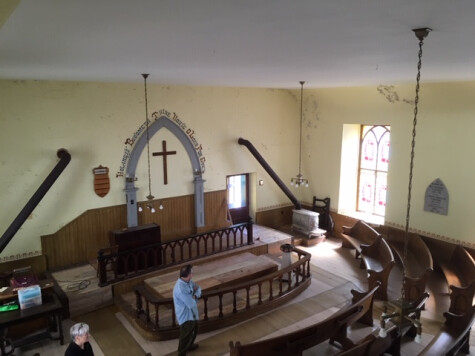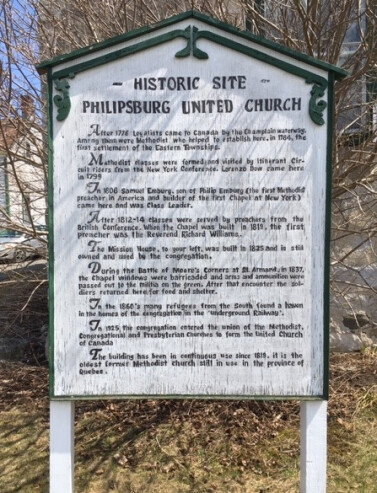Traveling the Circuit #13: Philipsburg Church

Monique’s and Joseph’s new bedroom has something that few couples can boast: graffiti, now 180 years old, carved into the woodwork by British soldiers who were billeted there. That’s because the new residence was, until just a few years ago, the Philipsburg United Church, part of the Bedford Pastoral Charge and, until recently, the oldest Methodist church building still operating as such in Quebec. The congregation has discontinued, but the legacy embodied in its walls still speaks to the knowing traveler. And how is it that a private home, once a church building, was quartering men in red coats? Read on.

Graffiti carved in the nineteenth-century by British soldiers billeted in the church.
Located just two miles north of the border with Vermont along the shore of the Bay of Missisquoi (a northern arm of Lake Champlain), Philipsburg, established in 1784, was the first settlement in the area and once known as the “gateway to the townships.” The Eastern Townships of Quebec, then called Lower Canada, were settled by “Tories” – or United Empire Loyalists, as they are known there – who fled north during the American Revolution or just afterward. In 1819, settlers erected a building for the meetings of the Methodists in the community. A strong structure with stout stone walls at the top of the town’s main street, Philipsburg Methodist was designated a “garrison church,” able to double as a fort or barracks in time of emergency. That actually happened twice. The first time was in 1837, during the Battle of Moore’s Corners (now St. Armand) in the course of the Lower Canada Rebellion, when British militia
 In the first half of the nineteenth century, two main offshoots of the faith of the Wesleys vied for prominence in Canada. The Episcopal Methodists, whose organization traced its beginnings to Francis Asbury and vigorous American preachers who came up from “south of the border,” were strongest in Upper Canada (today’s Ontario), where they grew into the largest Protestant denomination in that region. Lower Canada and the Maritime Provinces were harder fields of service, and there the British Wesleyans predominated, drawing their support, leadership, and political
In the first half of the nineteenth century, two main offshoots of the faith of the Wesleys vied for prominence in Canada. The Episcopal Methodists, whose organization traced its beginnings to Francis Asbury and vigorous American preachers who came up from “south of the border,” were strongest in Upper Canada (today’s Ontario), where they grew into the largest Protestant denomination in that region. Lower Canada and the Maritime Provinces were harder fields of service, and there the British Wesleyans predominated, drawing their support, leadership, and political
 Philipsburg is significant in African-American history, in two ways. A short distance from the town is a rocky promontory, next to which lie the graves of many blacks who came north as enslaved persons with their Tory masters. (“We Canadians like to think that we never had slaves,” said a local resident when I visited, “but it isn’t so.”) Today the site is on private property, but media attention in the summer of 2018 created new interest in this aspect of Canadian (and American) history. In the early 1860s, the community was a waypoint on the Underground Railroad, as black Americans fleeing slavery found refuge in the homes of the members of Philipsburg Methodist Church. Local lore says that this fact was kept very quiet at the time, as people were afraid of reprisals by
Philipsburg is significant in African-American history, in two ways. A short distance from the town is a rocky promontory, next to which lie the graves of many blacks who came north as enslaved persons with their Tory masters. (“We Canadians like to think that we never had slaves,” said a local resident when I visited, “but it isn’t so.”) Today the site is on private property, but media attention in the summer of 2018 created new interest in this aspect of Canadian (and American) history. In the early 1860s, the community was a waypoint on the Underground Railroad, as black Americans fleeing slavery found refuge in the homes of the members of Philipsburg Methodist Church. Local lore says that this fact was kept very quiet at the time, as people were afraid of reprisals by
In earlier times, Philipsburg was the leading church on its circuit, sending out missionaries to plant other faith communities as far away as Sherbrooke, 80 miles to the east. A manse (parsonage), also used as the Mission House or education building, was built adjacent to the church in 1825; it still stands today. The congregation boasted a large junior choir; its size was such that an internal remodeling was necessary to accommodate the crowd.
By the 1980s, however, the congregation was in its final decline. After three years without pastoral leadership on the charge, the membership had dropped to seven persons, and the Bedford Charge made the decision to close the church and to sell the site.
Last spring, I had the privilege of visiting new owners Monique and Joseph at their home in
 Philipsburg Church is located at 194 Montgomery Street, Saint Armand, Quebec J0J 1N0, adjacent
Philipsburg Church is located at 194 Montgomery Street, Saint Armand, Quebec J0J 1N0, adjacent
While from one perspective it’s regrettable that the community is no longer sustained spiritually by a thriving Wesleyan fellowship, we can give thanks that the church still stands as
Draft 2.1
Seattle, Washington; 3 October 2018
Solomons, Maryland; 22 October & 18 November 2018
S.D.G.
